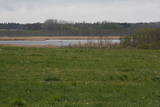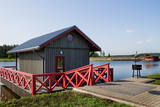| Nr | Name | Beschreibung |
|---|---|---|
|
Die im 19. Jh. gebauten Mühlen sind vollständig renoviert. Eine Erzählung über ihre Geschichte und einem originalen Arbeitsmechanismus. |
||
|
Es gibt eine Erzählung über einen dänischen Händler, der sich bei einem Schiffbruch am Kap von Kolka gerettet und als Dank in Kolka eine Kirche gebaut hat. In Kolka hat es mehrere Kirchen gegeben, die ihren Standort gewechselt haben. Das Fundament des heutigen aus Feldsteinen gebauten Gotteshauses hat der damalige Inhaber des Landgutes von Dundaga Karl Ludwig Ferdinand von der Osten-Sacken gelegt. Das Gotteshaus ist an der Stelle (oder in der Nähe) der hölzernen Kirche gebaut, die sehr stark im Krimkrieg gelitten hatte. Die ersten Bauarbeiten wurden von dem Baumeister Oto Zīverts im Jahr 1885 (Architekt Teodors Zeilers) angefangen. Während der Sowjetzeit wurde die Kirche gewaltsam ausgeraubt und in dem Gebäude wurde ein Lagerraum eingerichtet. Es ist wert, das moderne Altargemälde (Künstlerin Helēna Heinrihsone) zu besichtigen, dem kein anderes Altargemälde in keiner anderen Kirche ähnlich ist. Früher befand sich an der Stelle des Gemäldes ein Kreuz. |
||
|
Bis 1724 gehörte das Gut damals als Vorwerk Cecina der Familie Hylzen. Nachdem die Tochter Jadvyga Jan Szadurski geheiratet hatte erscheint das Gut 1774 in Dokumenten unter dem Namen Malnava. Weiterhin gab es noch mehrere Besitzerwechsel. Das Hauptgebäude des Gutes ist im Stil des Klassizismus errichtet, teilweise mit barocken Zügen. Auf einer Seite des Gutshofes befindet sich ein Speicher, das Herrenhaus befindet sich an der Stirnseite des Hofes. Zum Zeitpunkt der Bodenreform in Lettland 1920 war das Gut Malnava mit 12.400 Heltar eines der größten Güter in Lettland. Das Gutshaus wurde im 2. Weltkrieg zerstört, zwar wurde es wiederaufgebaut, aber die Inneneinrichtung ist nicht erhalten. Von den Wirtschaftsgebäuden ist der aus der ersten Hälfte des 19. Jh. stammende klassizistische Speicher erhalten sowie einige weitere Gebäude. Das Gutsensemble wird von einem Park ergänzt, in dem jetzt immer noch einige fremdländische Bäume und Sträucher wachsen, z.B. ein Amur-Korkbaum. Es gibt auch zwei Stahlbetonbunker, wo Hitler Mal kurze Zeit anwesend war. Auf dem Territorium befindet sich auch die Schnapsbrennerei der Marke „Latgales šmakovka“, wo Besucher sich mit der Herstellung von Hochprozentigem von frühesten Zeiten bis heute bekannt machen können. |
||
|
Das Gotteshaus ist von 1937 bis 1940 gebaut worden und als sein Prototyp hat die Auferstehungskirche in Kaunas in Litauen gedient. Die Kirche ist ein einschiffiges Gebäude, das in geometrisch rechteckigen Formen gebaut ist, die dem Stil Funktionalismus charakteristisch sind. In der Kirche befindet sich ein großer Altar aus Holz, eine Kanzel und zwei Seitenaltäre (am Anfang des 19. Jh. hergestellt), die früher die Kirche von Rokišķi geschmückt haben. Aus der Kirche von Rokišķi wurden die beiden Altäre hier gebracht, weil in der Kirche von Rokišķi eine neue Innenausstattung hergestellt wurde. Im Jahr 1997 hat die Kirche die Blaue Fahne des Europäischen Kulturerbes erhalten. Neben dem Gotteshaus befinden sich das in der zweiten Hälfte des 19. Jhs. aus roten Ziegeln gebaute Tor der katholischen Kirche und der Park der Selen. |
||
|
Izteiksmīgs zemesrags, kas klāts ar
dažāda lieluma laukakmeņiem.
|
||
|
Die Molkerei von Talsi wurde 1922 bei dem Zusammenschluss einiger anderen Molkereien gegründet. Später entstand auf dieser Basis die “Talsu piensaimnieks” AG. Eins der bekanntesten Produkte des Betriebs ist der Käse "Talsu ritulis" (der Käselaib von Talsi). Die Produktion von der “Talsu piensaimnieks” AG – Milch, Kefir, Quark, Butter, Käse u.a. kann man in einem zum Betrieb nahegelegenen Geschäft „Piena sēta” kaufen. |
||
|
Das Museum befindet sich in der Festung von Kopgalis. Im Aquarium des Museums sind Fische und Tiere der Ostsee und anderer Meere und Ozeane zu sehen. Eine Ausstellung. Pinguine und Seehunde. In den Pulverkellern der Festung ist eine Ausstellung der Seefhrt Litauens, aber auf den Bollwerken eine Ausstellung der Gewehr eingerichtet. Das einzige Delfinarium im Baltikum. |
||
|
Nature restricted area surrounds Tasu Lake and swampy shores of it in a narrow band. The territory was established to protect rare nesting and migratory birds. The territory is easily overseen from the narrow gravel roads all around the area not entering the actual protected area. Tasu Manor house is located to the South of nature restricted area.
|
||
|
Das Café befindet sich am Ufer des Flusses Daugava zwischen Stukmani und Plavinas und es ist mit einer Bäckerei und einem Geschäft verbunden. Mehrere dutzende Brotsorten, Gebäck, Torten, Kuchen und Brötchen. Lettische Küche: Suppe mit Fleischbällchen, Ampfersuppe, Bauernfrühstück, Spiegeleier, Schweinerippen, graue Erbsen, Kartoffelpfannkuchen mit Lachs, dünne Pfannkuchen, Brombeercreme. Das besondere Gericht: Roggenbrot von Liepkalni, Brotkwass. |
||
|
The castle diner is situated next to Koknese castle ruins. Either before or after boating, Nordic walking, visiting the castle ruins, enjoy tasty coffee, baked buns, snacks, french fries, grilled sausages, ice-cream or buy a soft drink to go with your sandwiches and to drink while sitting in the courtyard of the ancient castle and watching an amazing view of Perse and Daugava crossing. Upon special request we can also cook our very tasty Firesoup. |
||
|
Tūrisma gide Ineta Jansone piedāvā ekskursijas grupām uz Melnalkšņu dumbrāja laipu. Melnalkšņu dumbrāja laipa ir viena no īsākajām un interesantākajām takām Ķemeru nacionālajā parkā (600 m). Melnalkšņu dumbrājā Vēršupītes krastos novērojami dabiskam mežam raksturīgi elementi – jauni, kā arī veci un dobumaini koki, kritalas, sausoņi, ciņi. Daudzveidīga ir meža putnu fauna. Jebkurā gadalaikā melnalkšņu dumbrājs ir īpašs. Taču visā krāšņumā dumbrājs atklājas tieši pavasarī. Vēršupītes pālu laikā ūdeņi pārklāj lielāko dumbrāja daļu, bet visapkārt zied zeltainās purenes, gaiss vibrē no putnu dziesmām un dzeņu bungošanas. |
||
|
Das Gestüt erwartet als Gäste nicht nur professionelle Reiter oder Leute die Reiten lernen. Für Schüler ab der 6. Klasse werden Führungen angeboten, bei denen diese mit den Tieren bekannt gemacht werden, sie gefüttert werden können und man probieren kann zu reiten. Bei älteren Schülern kann das Programm auch etwas anspruchsvoller sein und Details zur Evolution und Biologie der Pferde enthalten und zur Arbeit mit den Tieren. Zudem werden Reittouren durch die Umgebung auf einfachen Strecken angeboten. |
||
|
Befindet sich am höchsten mit Bäumen bewachsenen Ufer des Flusses Marki hinter der Grenzkontrollstelle von Piedruja. Zur Kirche führt eine Straße aus Pflastersteinen, die wahrscheinlich die einheimischen Bauer am Anfang des 20. Jahrhunderts gelegt haben. Es war eine Pflicht, ein Stein mitzunehmen, wenn man zum Gottesdienst geht. Dieser Stein wurde später für den Straßenbelag verwendet. Diese Kirche mit sechs Kuppeln ist eine der schönsten im heutigen Bezirk Krāslava. Die Kirche ist von 1883 bis 1885 an der Stelle der alten Holzkirche gemäß den architektonischen Formen der altrussischen Stadt Wladimir und bisantischen architektonischen Formen (17. Jahrhundert) gebaut worden. Es gibt Informationen, dass die Größe der Gemeinde ehemals sogar eine Tausend Gemeindemitglieder erreichte. |
||
|
Die alten Torfbrüche – der nächste Ort
gleich nach Ķemeri, wo in noch größerem
Maße (hauptsachlich während der ersten
Unabhängigkeit von Lettland) Torf gewonnen
wurde.
|
||
|
This 368 metre structure is the highest television tower in the European Union. Its viewing area, which is at a height of 97 metres, is the highest publicly available viewing area in Latvia. The location offers a fantastic view of Rīga and Old Rīga to Pārdaugava, the Bay of Rīga and Sigulda – a radius of at least 50 kilometres.
|
||
|
Atrodas pilsētas centrā - Tirgus laukuma malā. Dievnams tapis 1495. g., pēc Livonijas ordeņa mestra Valtera fon Pletenberga (~ 1450. – 1535.) pavēles. Gadsimtiem ritot, ēka pārbūvēta un tagad redzamais tornis celts 1907. g. Baznīcā apskatāmi nozīmīgi kultūrvēstures pieminekļi: altārglezna “Golgāta” - H. Kīperta darināta kopija (pēc K. Arnoldi Kandavas luterāņu baznīcas oriģināla (1864. g.)), muižniekam Fīlipam Drahenfelsam veltīta epitāfija (B. Bodekers, 16. un 17. gs. mija), A. D. Tīzenhauzenas kapu plāksne (1648. g.), kristāmtrauka pamatne (18. gs.) un piemiņas plāksne 1. pasaules karā un Latvijas Brīvības cīņās kritušajiem draudzes locekļiem (1925. g.). Ap Tirgus laukumu (atjaunots, jauka strūklaka) izvietojies Dobeles vēsturiskais centrs. |
||
|
Das Restaurant befindet sich im Park von Smiltene: im Tal des Flusses Abuls, in der ehemaligen Brauerei des Landgutes. Nebenan befindet sich die Brauerei von Smiltene, wo Zider hergestellt wird, darum können Gäste diesen Apfelwein und auch einen Hauswein verkosten, der aus einheimischen Beeren hergestellt ist. Lettische Küche: Kalte Suppe, Schweinfleisch mit Zwiebeln, Kartoffelpfannkuchen, geschichtetes Roggenbrot-Dessert, Haferflocken mit Schlagsahne. Das besondere Gericht: Brauhaus: Eine gefüllte Schweinfleischrolle. |
||
|
So wird eine 6 km lange und einsame Wegstrecke zwischen den Dörfern Ragaciems und Klapkalnciems genannt, wo laut Erzählungen in alten Zeiten Reisende von Räubern überfallen wurden. Ungefähr 1,5 km vor Klapkalnciems (von der Seite des Dorfes Ragaciems) befindet sich an der Küste in einer Düne ein Gedenkstein, der den Kämpfen der finnischen Jäger gewidmet ist und der am 9. Dezember 1997 enthüllt wurde. Der Stein ist hierher aus dem Südosten Finnlands gebracht worden, wo im Jahr 1940 er als Panzerabwehr gedient hat. Auf dem Gedenkstein ist folgendes eingraviert: „Hier haben während des Ersten Weltkriegs vom August bis Dezember 1916 finnische Jäger gekämpft.“ Aber im Dorf Klapkalciems ist ein Gedenkstein enthüllt worden, wo fünf finnische Jäger beigesetzt worden sind. |
||
|
In the recreation complex it is possible to fish in the carp pond, as well as to swim and sunbathe on the landscaped beach on the loungers. There is a playground for children. It is also possible to organize banquets, seminars and other events. There is also a sauna with a fireplace hall for relaxation for up to 20 people. There are four campsites for accommodation, located above the water on piles. All cottages are heated, with separate shower and toilet, TV and wi-fi internet. Two of them have a kitchen, and one has a fireplace. Each cottage has three or four beds. Tents and camper sites are also available, and tents can be rented on site. |
||
|
This is the highest church tower in Latvia, and from it you can see views of the Alūksne highlands. The view to the South is particularly impressive.
|
||

















